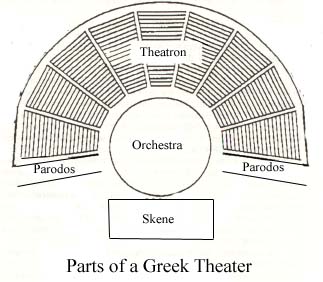Greek Theatre.
Dionysus and Entertainment Theatre.
Dionysus was the god of wine, fertility and theatre in ancient greek times. The greeks used theatre to worship him (before plays a goat was sacrificed to Dionysus) but it was also an important part of their life and culture as it was the first time theatre was used as an entertainment service. The ancient greeks would pay to watch plays and expected a night of relaxing fun so play writes like Euripides and Sophocles had to constantly write and produce plays in order to keep the people happy. Indeed, the first play writes and actors became early celebrities - everyone had their favourite play and actors.

The structure of plays.
Greek plays were performed in circular outside theatres called amphiteatres. There were three parts to an amphitheatre.
The first and most important was the orchestra - a flat peice of ground that the chorus performed on. The chorus was an integral part of greek theatre as they were the narrating ensemble of the plays who told the story through dance and song.
Whilst the chorus perfromed on the orchestra, the actors performed on the skene behind them (the word scene is derived from skene). Unlike the chorus, the actors on the skene wore elaborate masks usually made from baked clay or wood, carved and shaped into faces showing only 1 emotion.
To wacth the chorus and actors tell the story in parralel, the audience sat in the theatron. The theatron was usually cut into the side of hill and audience members were expetced to bring their own seats/cushions.
Case study - Medea.
Often, greek plays followed on from one another in a long series (one example of this is Antigone which follows after the events of Oedipus the King.) Medea, a greek tragedy written by Sophocles in 431 BC, is another example of this because it follows on directly after the events of Argonautica.
Plot:
-Jason (a powerful hero) sails across what is known today as the black sea in his ship the Argo in order to reach Colchis. He sails with a team of other heroes, collectively called the Argonauts, and brings back home the golden fleece to Greece.
-He also brings home a wife - a powerful sorceress named Medea whom he agreed to marry if she helped him slay a dragon to claim the fleece. Upon Jason and Medea's return to Athen's they have two children but life soon becomes more complicated.
-The king of Athens approaches Jason and asks him to marry his daughter (the princess of Athens) as he believes that only a great hero like Jason is worthy of her hand. Jason agrees and tells Medea he is going to marry the princess.
-She doesn't take it very well and kills the princess on the night of her wedding with Jason. Fleeing the wedding, Jason returns home to protect his children from the people of Athens who loved the princess dearly and so want to kill Medea.
-However, when he arrives home he finds his children murdered by Medea who then flees Greece. The play ends with Jason lamenting his fate.
This play is a very typical greek play for lots of reasons:
1. It has a chorus who interact with and tell the story through the other characters.
2. It follows the events of myths and legend (Jason never lived and the golden fleece is not real).
3. The play is written in verse - there are very few speaking lines from any characters.
Medea was incredibly popular at the time because of its crude message: foreigners (known as barbarians) are not to be elevated into Greek society as the disasters are immediate and extreme. The ancient Greeks loved this theme as they were incredibly proud of their country.